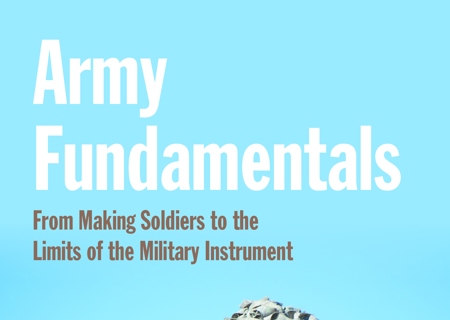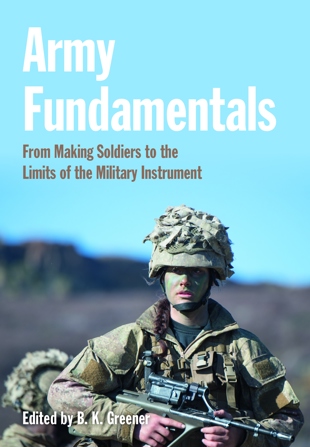Disclaimer: The following comments reflect the personal opinion of the writer, and do not reflect either an official NZDF position, or the opinion of any other member of the NZDF.
Issues around the performance of New Zealand Army personnel, their employment on operations abroad, and the way that they present themselves and – in a very real sense – represent New Zealand on the world stage have been brought into our national awareness over the past few decades, through our involvement in peace making and peace support operations in the likes of Bosnia, Bougainville, Timor Leste, and throughout the Middle East. Occasionally that awareness turns to heightened interest, such as we saw in the political and media response to a recent publication about New Zealand special forces operations in Afghanistan.
Notwithstanding that that particular work has now been discredited, it did highlight a feature of the discourse about the New Zealand Army: a lack of real understanding about the Army as an organisation, the individuals who serve in it, how they are ‘made’, and how they are employed.
The military historian, John Keegan, once rated the New Zealand infantrymen of both World Wars alongside the German infantry of World War One, the Ghurkhas, and the United States Marine Corps of World War Two as being the best light infantry of the 20th Century. I suspect that few New Zealanders would be aware of this, although I also suspect that, once told, the opinion would be indelibly stamped in their consciousness forever thereafter. Perhaps this is a result of the Anzac legends which presented New Zealanders as natural or ‘born’ soldiers – a belief that has been challenged by more considered analysis by historians in recent times, but nonetheless retains sentimental currency. While sentimentality has its place, however, the reality is that soldiers are not born, they are made.
In that sense, Army Fundamentals is a very important and timely piece of work. As its subtitle, ‘From Making Soldiers to the Limits of the Military Instrument,’ suggests, it seeks to answer a number of fundamental questions about the New Zealand Army in the 21st Century. These questions include:
- Who are we?
- What are we?
- Why are we who and what we are?
- Where are we going?
These are all important questions, and the debate around them and answers to them will have wide relevance.
- They are relevant to the politicians who make the decisions around resourcing and employment of the Army and wider NZDF; and to the policy makers who advise on that resourcing and employment.
- They are relevant to the academic community, who have an important role to play in that debate.
- They are important to the New Zealand public, who the Army (and wider NZDF) ultimately serve.
- And they are important to the women and men of the New Zealand Army iself.
Army Fundamentals seeks to address these questions through the contributions of a range of ‘exciting new scholars, current practitioners and established academics.’ The multi-disciplinary contributions draw heavily on close (and, in a number of cases, long-term) engagement between the scholars and academics and members of the New Zealand Army, and also on the personal experiences and observations of the practitioners. The result tests theory against practice, and vice versa.
Dr Nina Harding and Maike Guesgen examine the acculturalisation and induction process through an anthropological lens. Their contributions, which are based on interviews and observations, highlight the different experiences of new recruits in full-immersion induction programmes such as Basic Training at The Army Depot on the one hand, and an atypical, blended programme (the former Kippenberger university-based Scheme) on the other, and show how these different experiences could produce entirely different results. These had implications for the way the two groups came together as cohorts, and their consequent attitudes towards some of the odd characteristics of military life. Harding’s and Guesgen’s observations are useful and relevant, and demonstrate what an anthropological approach can bring to the debate.
The chapters by Samantha Morris, Dr Peter Greener and Dr Michael Lauren look at the issues around the identity of the New Zealand soldier: how they see themselves, how they perceive how others see them, and how they are really seen by others. Although the resulting picture is generally complimentary to the New Zealand soldier, and indeed might seem to confirm aspects of the Anzac legends I referred to earlier, the three chapters do sound a number of cautionary notes.
The first of these is the requirement to understand the difference between cultural appreciation and cultural competence. The evidence suggests that while most New Zealand soldiers have the former almost by instinct, the latter is more difficult to attain, and indeed must be developed via a conscious, deliberate process. The development of cultural competence is an important issue, and must be a key part of Army personnel capability development planning in future.
The second cautionary note, which is raised quite explicitly by Lauren, involves the inherent conflict between the generalist versus specialist approach that might occasionally stretch the resource and/or technical capabilities of our personnel on operations. This, again, provides a challenge for the senior leadership of the New Zealand Army, the NZDF, and our political masters. It is a challenge that deserves – indeed, demands – its own debate. Hopefully this book will spark that debate.
Kiri Stevens and Beth Greener’s case study of the RAMSI deployment to Solomon Islands examines the impact of that deployment on the personnel concerned, in terms of how they interacted with the operational settings, how they understood their roles and work in the context of those settings, how they saw the impact of their involvement in the deployment, and what the experience meant for their understanding of their identity and values. The chapter also addresses issues of gender in the military, and what has been called the ‘hyper-masculinity’ of military forces. These issues have implications that go far beyond the military itself, particularly with respect to conflict resolution and the involvement of female perspectives therein.
LTCOL Jane Derbyshire explores the gender theme further, by running a tape-measure over the current state of the Army’s moves towards gender integration, and what she calls the development of the ‘modern warrior’. Although – as she notes – New Zealand has been something of a leader in this regard, there still remains much to be done. The potential benefits, however, are significant.
LTCOL Josh Wineera examines the New Zealand Army’s involvement in Building Partner Capacity (or BPC) programmes. He discusses how the New Zealand Army has changed the way it conducts such missions, blending contemporary adult teaching and learning methodology with the characteristics of the New Zealand soldier to produce a unique approach to BPC.
In the final chapter, Bill Fish, Beth Greener, Nina Harding and Cameron Sigley bring together the range of themes that have been explored throughout the book, to make a number of salient observations about the limits of military action. Some of these observations challenge current thinking, such as the idea that highly-trained warfighters make better peacekeepers.
The authors highlight a particular challenge for the senior leadership of both the Army and the NZDF: that as the senior military advisers to government, they must intimately understand their organisations; and must be prepared to represent to government when their organisations are exhausted, or have reached the limit of their military capability and capacity. It is, in every sense, the capstone chapter of the book, and brings the earlier themes together wonderfully well.
Something that is clear throughout all the chapters, and which impressed me greatly, is the sense of engagement between the writers, their topics, and their audience. This is no dry treatise: rather, real-life anecdotes abound, which help support and sustain the discussion, and retain the reader’s interest.
Ladies and gentlemen, in closing I would like to draw your attention to Dr Cathy Downes’ Foreword to Army Fundamentals. Dr Downes states:
“Army Fundamentals opens the watch-face to show us some of the internal workings of the New Zealand Army. It also offers multiple perspectives on the social, demographic, economic and national cultural factors that are shaping the army’s current and future workforce. Its vignettes and case studies highlight the internal conflicts that its leaders must manage adroitly between its proven traditions and practices and the evolving social culture from which it must always draw its legitimacy. Finally, it puts the New Zealand context on the ongoing tensions faced by military leaders. These tensions involve designing and preparing military forces as uniformed, disciplined and armed ‘maids of all work’, while at the same time preparing for and conducting traditional tactical combat and combat support missions. In this, the authors and editors have done us a great service.”
Ladies and gentlemen, I am sure that, on reading the book, you will agree with Dr Downes’ summation. I congratulate the authors – many of whom are here today – for their contributions to this very important work. And I also congratulate Assoc-Prof Beth Greener for having the vision that shaped the project, and for her drive and professionalism in bringing together and aligning her and others’ contributions so effectively.
Beth, and all your team, thank you so much.
On that note, it gives me great pleasure to launch Army Fundamentals, and to commend it to you all.
Lieutenant Colonel Richard Taylor
Commandant, NZDF Command and Staff College
9 May 2017


